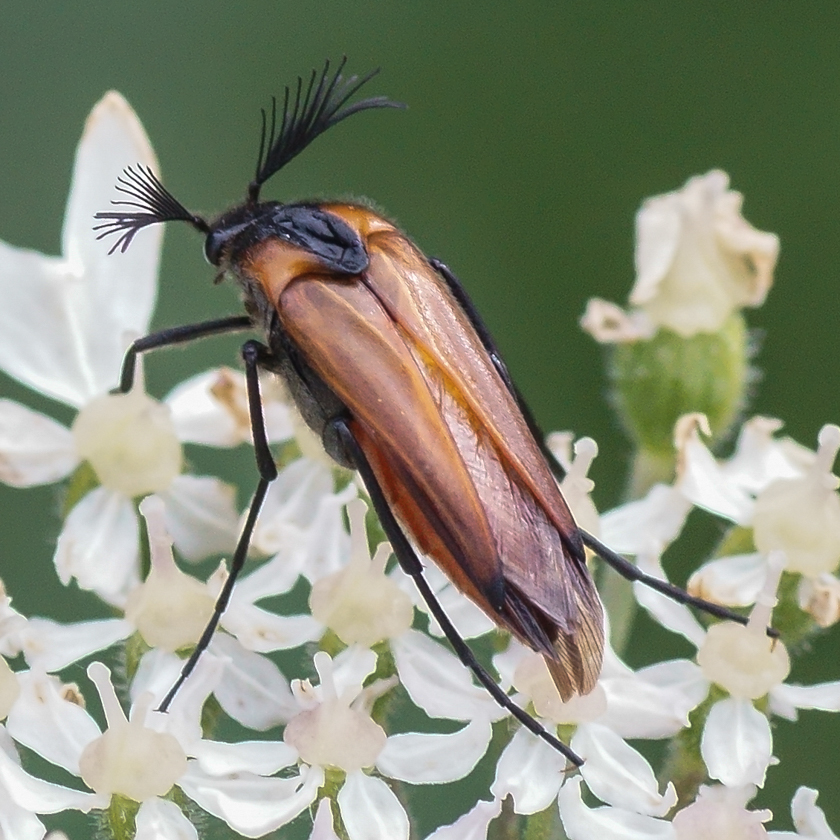
Paul writes: This is an unusual-looking beetle, the antennae are particularly striking and the elytra are very pointed and leave the end of the wings exposed. When I saw this one it took me quite a while to realise what I was looking at. As its name suggests the Wasp Nest Beetle (Metoecus paradoxus) is a parasite of social wasps, mostly Common Wasp (Vespula vulgaris) or German Wasp (Vespula germanica).
The beetle has a complicated life cycle and it had been identified for a long time before this was cracked. The beetle larva is an internal parasite of its host wasp larva, which it eats after emerging from the body. The larva then pupates and reaches adulthood in the wasps’ nest. In autumn, after leaving the nest and mating, the female beetle searches out for a suitable site to lay her eggs. The clever thing is that she chooses a site with rotten wood, which she knows the host wasp species will visit. The eggs over-winter and the larvae are just ready in summertime for when a suitable wasp comes along looking for some rotten wood to chew up to take back to the nest. One of the larvae then attaches onto the wasp and is taken to the nest where it selects a suitable grub to parasitize.
Records show that the beetle is widespread in England and Wales but not very often recorded. This is the only one I’ve seen. I found it in September, a few years ago, just outside my garden. I had noticed a wasp nest in the garden that year but this may have just been a coincidence. If you know of a wasp nest locally it is well worth keeping an eye open on umbellifers in early autumn, where the adult beetles wait around like this one, looking for a suitable mate.
[registration_form]
We have 3 wasps nests nearby this year and plenty of cow parsley and hog weed so I was interested in this photo.
I have googled the life history, all that rotten wood bit as in “chooses a site with rotten wood, which she knows the host wasp species will visit…. looking for some rotten wood to chew up to take back to the nest.” Now I have seen wasps chewing perfectly good dead/weathered wood such as fences, gates etc but not noticed them going for rotten wood. Thinking about it, rotten wood, where the cellulose has been digested by rot and destroyed will surely not be of any use to wasps. The eggs may be laid in rotten wood which is easy to penetrate and where they are safe and sheltered. In the original world without fences etc this would be a sign of dead wood nearby. Thinking of the hundreds of yards of post and rail fence near here that shows signs of wasp grazing it is a wonder the beetle species survives, with that much alternative wood source available to the wasps.
Is it time for a rethink.?
They can be numerous http://wbrc.org.uk/worcrecd/Issue13/metoecus.htm
That’s an interesting point Andrew. I imagine the life cycles of insects are very difficult to study and as you point out things change over time. How well the insect responds to these changes must determine how well it succeeds in surviving. How the population of the species has varied over the last hundred years or so I don’t know but imagine it has declined considerably like lots of other species. Social wasps seem very good at adapting to change maybe some of the species that parasitise them aren’t. It would make a good PhD study for someone. As I mentioned reports are quite scarce so it can’t be a beetle that is visible for long after it leaves the nest, although when it occurs in a roof space or similar it may be abundant around somebody’s house. So it probably is time for a rethink but will have to join an ever increasing queue for peoples interest.